Deschutes National Forest
- January 4, 2024
- 0 comment
Deschutes National Forest is a breathtaking expanse of natural beauty located in Central Oregon. Spanning over 1.6 million acres, this forest boasts a diverse landscape of dense forests, pristine lakes, and stunning mountain vistas. Whether you’re an avid hiker, fisherman, or simply looking for a peaceful escape, Deschutes National Forest offers endless opportunities for outdoor adventure. With over 1,000 miles of trails, visitors can explore the forest on foot, horseback, or mountain bike, and discover hidden waterfalls, ancient lava flows, and unique wildlife.
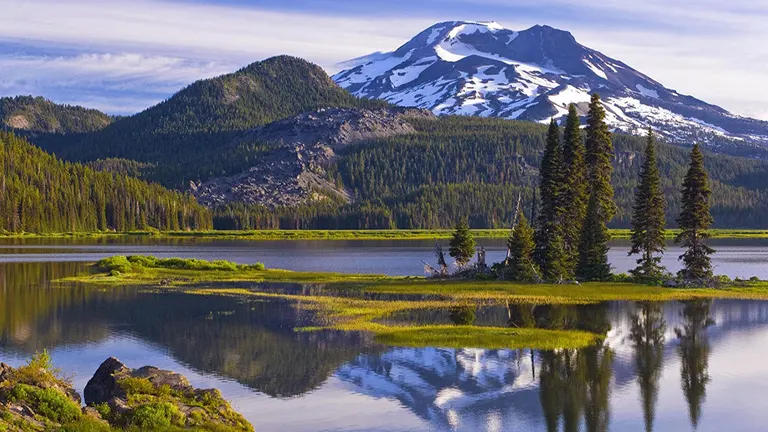
Characterizing Features of the Deschutes National Forest
- Geographical Diversity: The Deschutes National Forest spans 1.8 million acres along the eastern slopes of the Cascade Range, showcasing a rich tapestry of landscapes. From dense forests and alpine lakes to volcanic mountains and meandering rivers, its geographical diversity creates a stunning backdrop for a myriad of outdoor activities.
- Historical Significance: Established in 1908, the Deschutes National Forest has played a vital role in the economic and social history of Central Oregon. Initially part of the Cascade Forest Reserve, it evolved into a major timber supplier during the region’s economic reliance on mills. Today, it stands as a testament to the intertwined history of human activity and environmental conservation.
- Recreational Haven: Welcoming over 8 million visitors annually, the forest is a recreational haven, offering activities for every season. Whether camping, fishing, hiking, or skiing, the Deschutes National Forest provides an immersive experience for outdoor enthusiasts, making it a popular destination for those seeking adventure and natural beauty.
- Newberry National Volcanic Monument: A standout feature within the forest, the Newberry National Volcanic Monument is a geological wonderland. Home to cinder cones, lava flows, and lava tubes, it provides a unique opportunity to explore the remnants of past volcanic activity, adding an extra layer of fascination to the forest’s natural allure.
- Rich Biodiversity: Beyond its scenic vistas, the Deschutes National Forest boasts a diverse range of flora and fauna. With over 250 known caves, five wilderness areas, and six National Wild and Scenic Rivers, the forest is a sanctuary for wildlife and offers an immersive experience for those seeking to connect with nature.
- Accessible Headquarters: The forest’s administrative hub is located in Bend, Oregon, providing a convenient starting point for visitors. With additional ranger district offices in Bend, Crescent, and Sisters, the Deschutes National Forest ensures accessibility and support for those exploring its vast and varied landscapes.
- Four-Season Appeal: One of the remarkable aspects of the forest is its year-round appeal. Whether blanketed in snow for winter sports, adorned with wildflowers in spring, offering shaded trails in summer, or displaying vibrant fall foliage, the Deschutes National Forest is a destination for all seasons, catering to a diverse range of outdoor interests.
History
The history of the Deschutes National Forest is a compelling narrative that unfolds against the backdrop of the Cascade Range in Oregon. Established in 1908, the forest’s origins trace back to the amalgamation of parts of the Blue Mountains, Cascade, and Fremont National Forests. In its early years, the Deschutes National Forest played a pivotal role as a timber supplier, contributing significantly to the core of Central Oregon’s economy during the era when mills dominated the region. Over time, the forest underwent administrative adjustments, with portions splintering off to form the Ochoco and Paulina National Forests in 1911, only to be reintegrated in 1915. The 1993 Forest Service study shed light on the forest’s ecological richness, estimating an extensive 348,100 acres of old growth within its boundaries.

Encompassing over 1.8 million acres, the Deschutes National Forest is not merely a historical relic but a dynamic landscape that has evolved to embrace its role as a recreational haven. The forest now draws more than 8 million visitors annually, offering diverse activities such as camping, fishing, hiking, and skiing across its scenic terrain. Today, the forest is not just a testament to its economic and social history but a living testament to the delicate balance between human activity and environmental preservation, ensuring its continued significance for generations to come.
Importance in Conservation and Recreation of Deschutes National Forest
The Deschutes National Forest holds paramount importance in the realms of both conservation and recreation, embodying a delicate balance between preserving ecosystems and providing a haven for outdoor enthusiasts. Encompassing 1.8 million acres along the eastern slopes of the Cascade Range, the forest is a sanctuary for biodiversity, boasting over 250 known caves, five wilderness areas, and six National Wild and Scenic Rivers. Its ecological significance is further underscored by the Newberry National Volcanic Monument, a geological marvel featuring cinder cones and lava flows. Conservation efforts within the Deschutes National Forest aim to safeguard these natural wonders, ensuring the continued existence of old-growth areas and sustaining the delicate ecosystems that flourish within its boundaries.
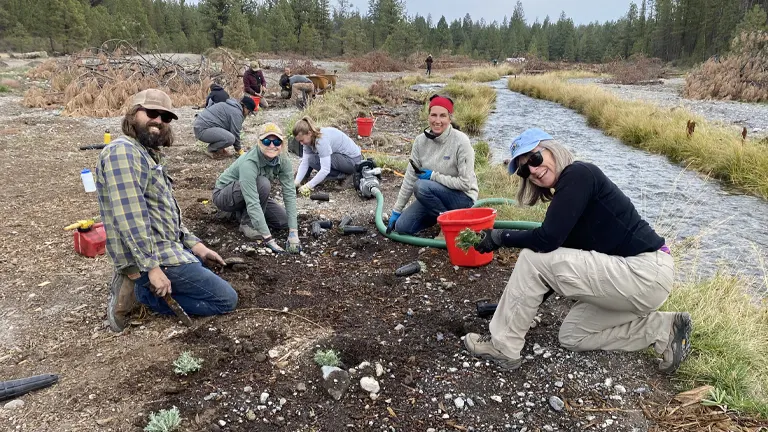
Simultaneously, the forest plays a pivotal role in catering to the recreational needs of millions of visitors annually. With more than 8 million people drawn to its diverse landscapes each year, the Deschutes National Forest provides an accessible and immersive outdoor experience. Camping, fishing, hiking, and skiing are just a few of the activities that make the forest a year-round destination. This dual role of conservation and recreation underscores the forest’s vital contribution to the well-being of both the environment and the communities that surround it, fostering a harmonious relationship between nature and those who seek solace, adventure, and inspiration within its sprawling domain.
Unique Location of Deschutes National Forest
The Deschutes National Forest occupies a truly unique and captivating location within the Pacific Northwest, nestled along the eastern slopes of the Cascade Range in Oregon. Encompassing a vast expanse of 1.8 million acres, its geographical position places it as a natural bridge between the arid landscapes of eastern Oregon and the lush greenery of the western part of the state. The forest’s diverse topography showcases a remarkable blend of ecosystems, from dense evergreen forests to high alpine meadows and volcanic landscapes.

This strategic positioning not only contributes to the forest’s ecological richness but also enhances its appeal for outdoor enthusiasts, providing a playground for activities such as hiking, camping, fishing, and skiing. The Deschutes National Forest stands as a testament to the geographical diversity that defines the Pacific Northwest, offering a mosaic of landscapes that make it a truly distinctive and sought-after destination for nature lovers and adventure seekers alike.
Diverse Vegetation and Plant Species in Deschutes National Forest
- Ponderosa Pines (Pinus ponderosa): The Deschutes National Forest is dominated by majestic ponderosa pines, a hallmark of the Pacific Northwest’s coniferous landscapes. These towering trees thrive in the forest’s diverse elevations, contributing to the scenic beauty and ecological integrity of the region.
- Douglas Fir (Pseudotsuga menziesii): Abundant in the forest, Douglas fir trees add to the rich tapestry of coniferous vegetation. Their dense evergreen foliage provides habitat for wildlife and contributes to the forest’s role as a haven for biodiversity.
- Western Hemlock (Tsuga heterophylla): Found in the wetter and cooler areas of the Deschutes National Forest, western hemlock trees contribute to the forest’s diverse microclimates. Their shade-tolerant nature and graceful appearance enhance the overall ecosystem.
- Lodgepole Pines (Pinus contorta): Particularly prevalent in the higher elevations, lodgepole pines are adapted to thrive in a variety of soil and moisture conditions. They play a crucial role in the forest’s resilience, showcasing adaptability to different habitats.
- Wildflowers: The forest floor comes alive with a vibrant display of wildflowers, adding color and diversity to the landscape. From lupines and Indian paintbrush to asters and lilies, these floral gems contribute to the overall biodiversity and seasonal allure of the Deschutes National Forest.
- Meadow Ecosystems: Within the forest, expansive meadows dot the landscape, harboring a unique array of grasses, sedges, and flowering plants. These open spaces not only provide a stark contrast to the dense forests but also serve as vital habitats for various wildlife species.
- Wetland Vegetation: Wetlands within the Deschutes National Forest host a variety of vegetation adapted to moist conditions. From sedges and rushes to willows and wetland wildflowers, these areas contribute to the forest’s ecological complexity and provide critical habitat for amphibians and waterfowl.
- Deciduous Trees: Amidst the coniferous dominance, deciduous trees such as quaking aspen and mountain ash add seasonal variation to the forest. Their vibrant autumn foliage paints the landscape with hues of gold and red, enhancing the visual spectacle of the Deschutes National Forest.
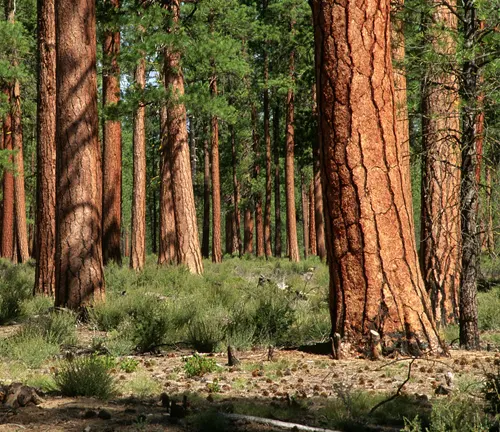

The diverse vegetation and plant species within the Deschutes National Forest create a dynamic and resilient ecosystem, fostering a habitat mosaic that supports a wide range of flora and fauna. This botanical richness not only contributes to the forest’s intrinsic beauty but also highlights its ecological importance within the broader context of the Pacific Northwest’s natural landscapes.
Fauna
- Elk (Cervus canadensis): The Deschutes National Forest provides a habitat for elk, one of the most iconic and majestic herbivores in the region. These large mammals roam the diverse landscapes of the forest, particularly thriving in the open meadows and dense woodlands.
- Mule Deer (Odocoileus hemionus): Mule deer are a common sight in the Deschutes National Forest, gracefully navigating through the forested areas and contributing to the overall biodiversity. Their adaptability to various habitats makes them a key species in the forest ecosystem.
- Black Bear (Ursus americanus): The forest is home to the elusive black bear, a symbol of North American wilderness. These omnivores play a crucial role in the ecosystem’s balance, foraging for berries, nuts, and occasionally hunting small mammals.
- Cougar (Puma concolor): Cougars, also known as mountain lions, inhabit the forest and play a vital role as top predators. Their presence regulates prey populations and contributes to the overall health and balance of the Deschutes National Forest ecosystem.
- Gray Wolf (Canis lupus): The reintroduction of gray wolves to the region has had a positive impact on the Deschutes National Forest’s biodiversity. These apex predators help control herbivore populations and influence the behavior of other wildlife species.
- Small Mammals: From beavers crafting intricate dams in streams to playful river otters and industrious squirrels, the Deschutes National Forest hosts a variety of small mammals. These creatures are integral to the forest’s intricate food web and ecosystem dynamics.
- Amphibians and Reptiles: Wetland areas within the forest provide habitat for amphibians such as the Pacific tree frog and various reptiles, including garter snakes and Western fence lizards. These species contribute to the overall biodiversity and ecological health of the forest.
- Trout and Fish Species: The rivers and lakes within the Deschutes National Forest teem with diverse fish species, including native trout. Fishing enthusiasts frequent these waters, contributing to both recreational activities and the management of fish populations.
- Bird Species: A haven for birdwatchers, the forest is home to a plethora of bird species. Songbirds, woodpeckers, and migratory species find refuge in the diverse habitats, making the Deschutes National Forest a birding paradise.


The Deschutes National Forest’s fauna reflects the richness and diversity of the Pacific Northwest’s ecosystems. From large mammals to birds, reptiles, and fish, the forest’s inhabitants contribute to its ecological complexity and make it a thriving hub of biodiversity.
Attractions in Deschutes National Forest
1. Newberry National Volcanic Monument
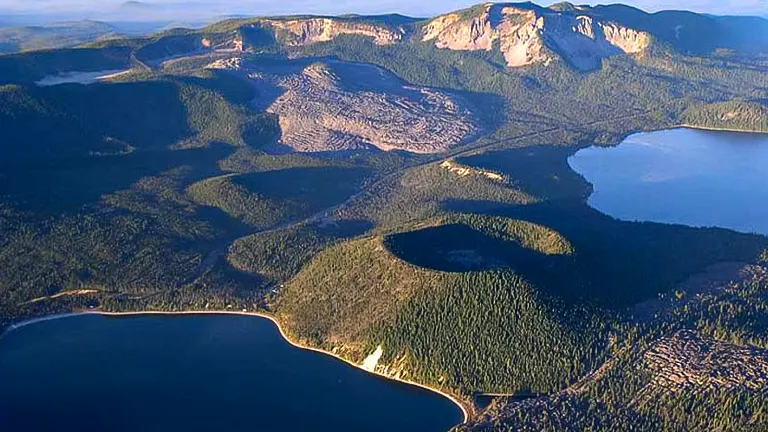
The crown jewel of the Deschutes National Forest, the Newberry National Volcanic Monument is a geological wonder encompassing cinder cones, lava flows, and fascinating lava tubes. Visitors can explore the unique landscape, hike to the summit of Lava Butte for panoramic views, or discover the Lava River Cave, an underground lava tube providing an extraordinary subterranean adventure.
2. Mount Bachelor
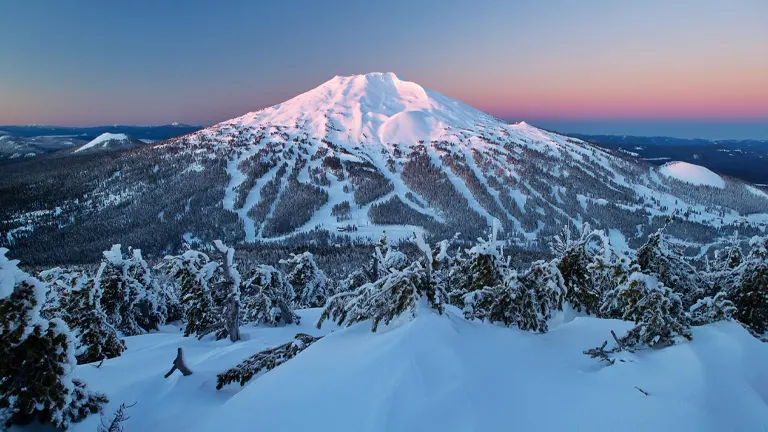
A prominent feature within the forest, Mount Bachelor offers year-round recreational opportunities. In winter, it transforms into a premier skiing and snowboarding destination, while summer invites hikers and mountain bikers to explore its trails. The breathtaking vistas from the summit make Mount Bachelor a must-visit attraction for outdoor enthusiasts.
3. Deschutes River
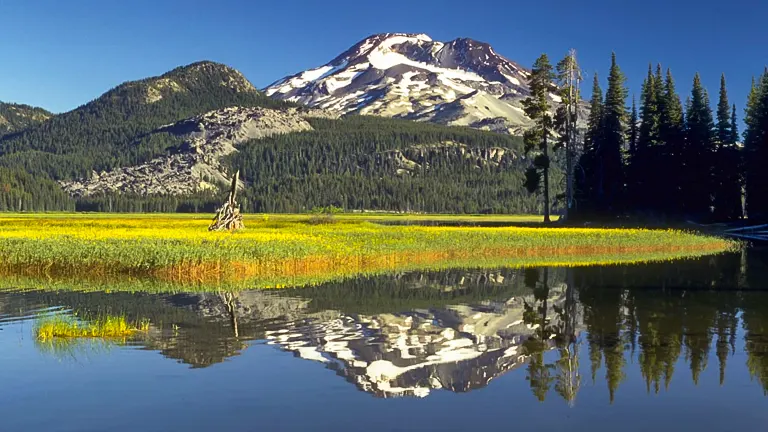
The Deschutes River is a central attraction, offering a myriad of recreational activities. Known for its excellent fly-fishing, the river also provides opportunities for rafting, kayaking, and stand-up paddleboarding. The Deschutes River Trail allows hikers and bikers to experience the scenic beauty along its banks.
4. Metolius River
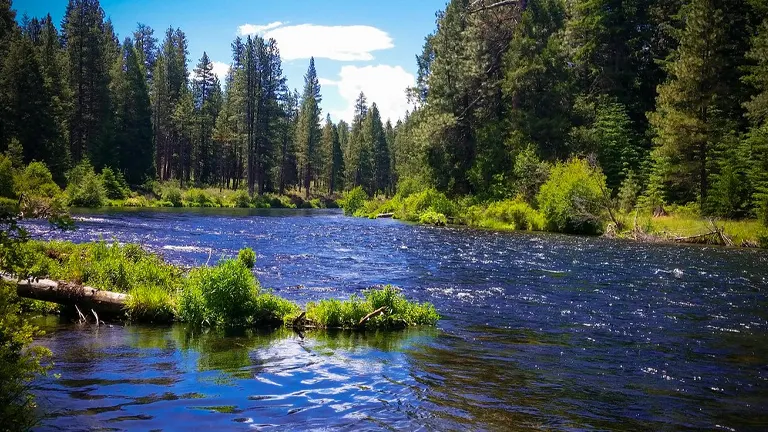
Renowned for its crystal-clear waters and vibrant aquatic life, the Metolius River is a fly-fishing paradise. The surrounding area is dotted with campgrounds and hiking trails, providing a serene escape for those seeking a quieter, nature-immersed experience.
5. Three Sisters Wilderness

A haven for backpackers and nature enthusiasts, the Three Sisters Wilderness encompasses three majestic volcanic peaks. With its pristine alpine lakes, lush meadows, and challenging trails, the wilderness area offers a backcountry experience, showcasing the untouched beauty of the Deschutes National Forest.
6. Paulina Lake
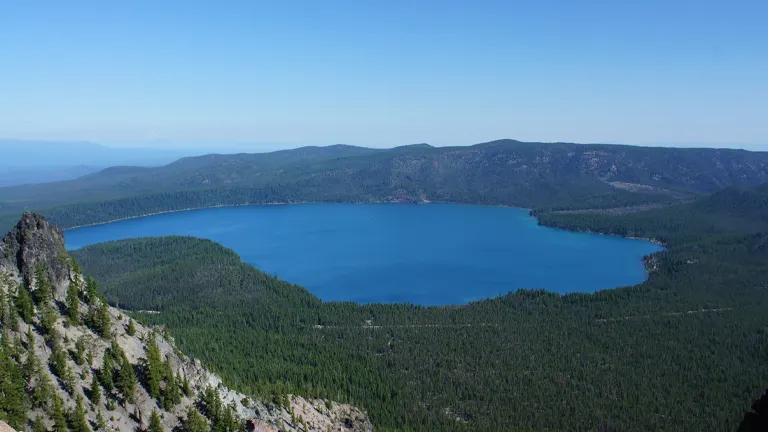
Nestled within volcanic calderas, Paulina Lake is a picturesque destination offering boating, fishing, and camping opportunities. Visitors can explore the lake’s surroundings, hike to viewpoints like Paulina Peak, or relax on the shores, taking in the breathtaking scenery of this tranquil high-mountain lake.
7. Tumalo Falls

Tumalo Falls stands as a natural spectacle, cascading over 90 feet down a rugged basalt cliff. Accessible by a short hike, the falls provide a refreshing retreat and a popular spot for picnics. The surrounding Tumalo Creek Trail offers additional exploration through lush forested landscapes.
8. McKenzie Pass – Santiam Pass Scenic Byway
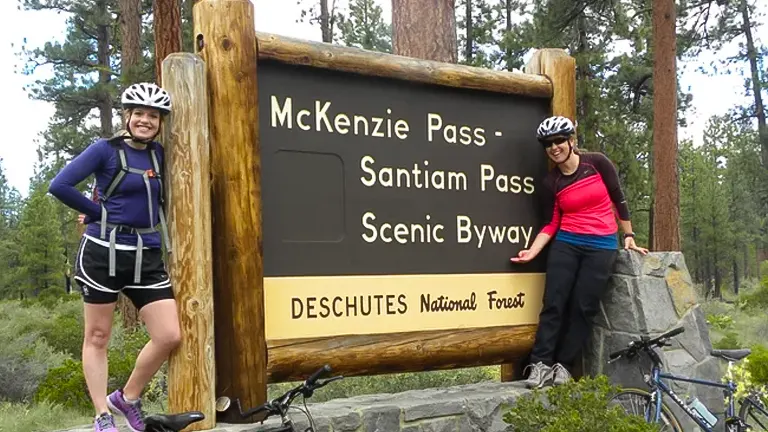
A scenic drive through the heart of the Deschutes National Forest, the McKenzie Pass – Santiam Pass Scenic Byway offers breathtaking views of volcanic landscapes, dense forests, and the rugged Cascade Range. The journey unfolds historical sites, such as Dee Wright Observatory, providing a unique perspective on the region’s geological history.
These attractions collectively showcase the diverse offerings of the Deschutes National Forest, inviting visitors to embark on a journey through its natural wonders, from volcanic landscapes and serene lakes to majestic peaks and cascading waterfalls.
Recreational Activities in the Deschutes National Forest
1. Camping
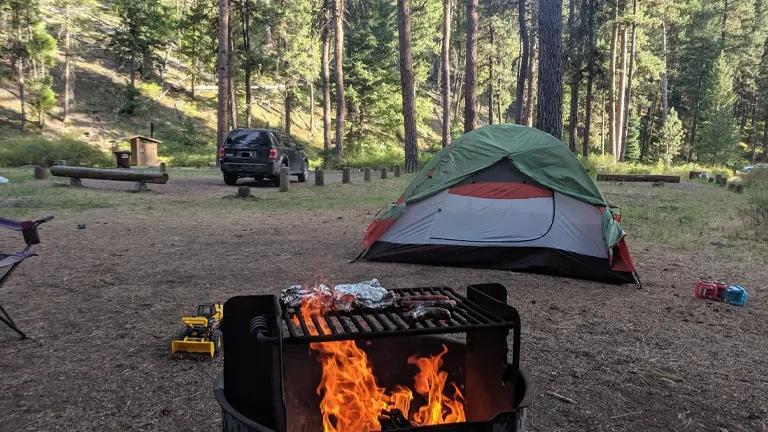
Camping enthusiasts find a plethora of options within the Deschutes National Forest, with over 125 developed and listed campgrounds. Ranging from small primitive sites to larger, well-equipped campgrounds, visitors can immerse themselves in the forest’s natural beauty while enjoying a range of camping experiences. Whether under the towering canopy of ponderosa pines or near alpine lakes, the diverse campgrounds cater to a variety of preferences.
2. Hiking
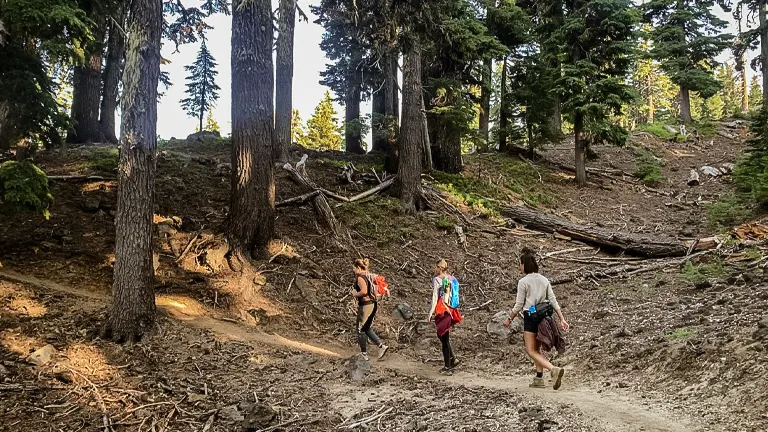
The extensive trail system in the Deschutes National Forest beckons hikers of all skill levels. From leisurely strolls through meadows to challenging backcountry treks, the forest offers a diverse range of hiking opportunities. Trails like the Deschutes River Trail and those in the Three Sisters Wilderness provide scenic vistas, alpine lakes, and a chance to explore the forest’s varied landscapes on foot.
3. Fishing
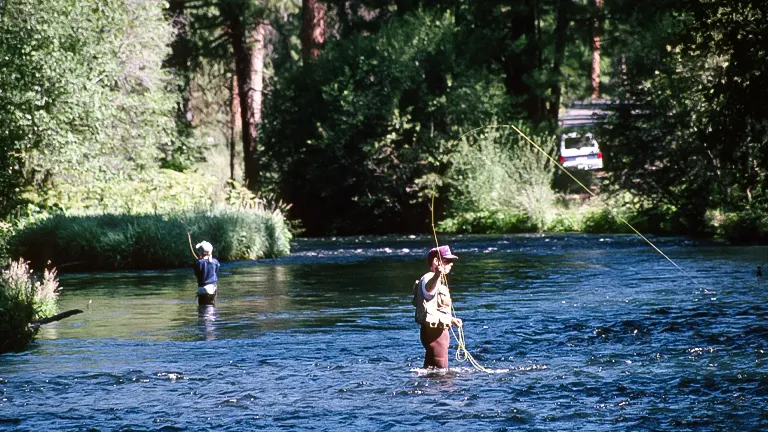
Anglers flock to the Deschutes National Forest for its renowned fishing opportunities. The Deschutes and Metolius Rivers are prized for fly-fishing, while lakes like Paulina Lake provide serene settings for traditional angling. The forest’s waterways teem with trout and other fish species, offering a rewarding experience for fishing enthusiasts.
4. Boating

The forest’s lakes and rivers open up opportunities for boating and water recreation. Paulina Lake, in particular, invites boaters to explore its pristine waters, surrounded by volcanic calderas. Whether kayaking, canoeing, or enjoying a leisurely boat ride, the Deschutes National Forest provides a refreshing aquatic escape.
5. Mountain Biking
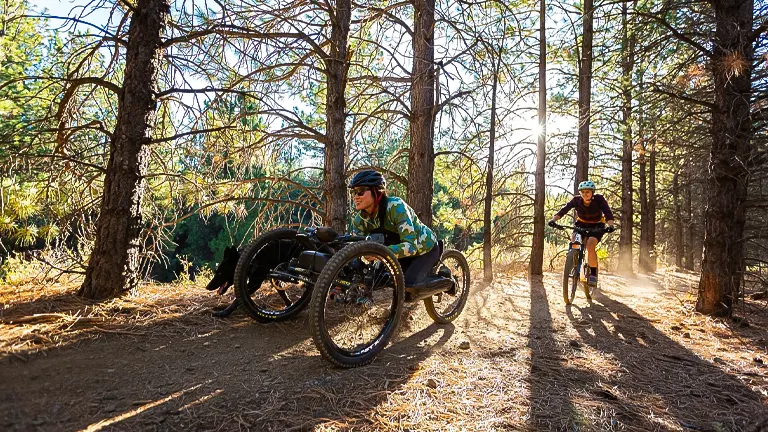
With a network of trails catering to mountain biking enthusiasts, the Deschutes National Forest offers thrilling rides through diverse terrain. Trails on Mount Bachelor and in the Phil’s Trail Complex are renowned for their scenic beauty and challenging yet rewarding biking experiences, making the forest a sought-after destination for mountain bikers.
6. Skiing and Snowboarding

As winter blankets the landscape, the Deschutes National Forest transforms into a snowy wonderland, attracting skiers and snowboarders. Mount Bachelor, with its varied slopes and reliable snowfall, stands as a premier winter sports destination, providing exhilarating downhill experiences and cross-country trails amidst a breathtaking alpine setting.
7. Wildlife Watching
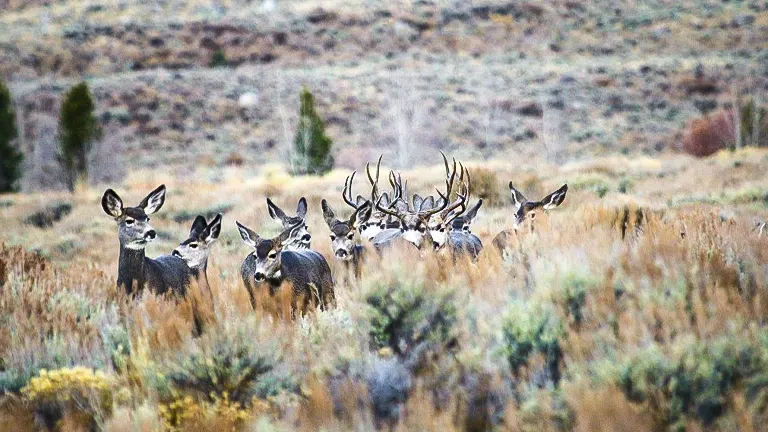
The forest’s diverse ecosystems make it an ideal habitat for wildlife, offering enthusiasts ample opportunities for observation. From elk and deer to raptors and smaller mammals, the Deschutes National Forest provides a captivating backdrop for wildlife watching. Patient observers may be rewarded with glimpses of these creatures in their natural habitats.
8. Rock Climbing
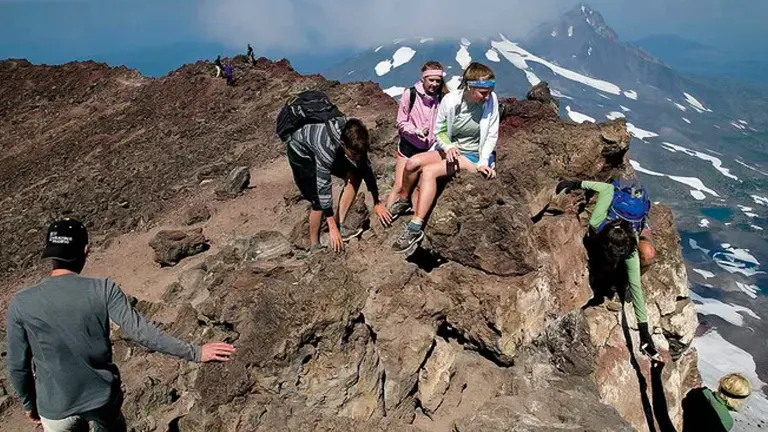
Adventure seekers and rock climbers are drawn to the unique geological formations within the Deschutes National Forest. Areas like Smith Rock State Park present challenging climbing routes against a dramatic backdrop of towering cliffs and rugged landscapes, making it a hotspot for those seeking vertical adventures.
The Deschutes National Forest stands as a recreational paradise, providing a diverse range of activities that cater to nature lovers, adventure enthusiasts, and those seeking a tranquil escape into the heart of the Pacific Northwest’s natural wonders.
Facilities and Amenities in Deschutes National Forest
- Campgrounds and Picnic Areas: The Deschutes National Forest boasts a network of over 125 developed and listed campgrounds, offering a range of camping experiences for visitors. From small, primitive sites nestled in the heart of the forest to larger, well-equipped campgrounds near lakes and rivers, these facilities provide essential amenities for a comfortable and immersive outdoor stay. Many campgrounds also feature picnic areas, allowing visitors to enjoy meals surrounded by the forest’s natural beauty.
- Visitor Centers: Throughout the forest, visitor centers serve as hubs of information, providing maps, educational exhibits, and guidance for exploring the vast terrain. The forest’s headquarters in Bend, Oregon, is a focal point for information, while local ranger district offices in Bend, Crescent, and Sisters cater to specific regions, ensuring that visitors have access to essential resources and knowledge for a seamless experience.
- Trailheads and Interpretive Signs: Well-marked trailheads are strategically placed throughout the Deschutes National Forest, facilitating easy access to the extensive trail system. Interpretive signs along trails offer valuable insights into the forest’s ecology, geology, and history, enhancing the visitor experience by providing context to the natural wonders encountered along the way.
- Boat Ramps and Docks: For those eager to explore the forest’s lakes and rivers, boat ramps and docks are available, ensuring convenient access to the water. Popular destinations like Paulina Lake feature facilities for boaters, kayakers, and canoeists, providing a gateway to the serene aquatic landscapes within the forest.
- Ski Resorts and Winter Facilities: During the winter months, ski resorts within the Deschutes National Forest, notably Mount Bachelor, offer a range of facilities for snow enthusiasts. From well-maintained slopes for downhill skiing and snowboarding to cross-country trails and cozy lodges, these winter facilities provide a full spectrum of experiences for those seeking snowy adventures.
- Fishing Platforms and Access Points: Anglers are catered to with fishing platforms and designated access points along rivers and lakes within the forest. These facilities enhance the fishing experience, providing safe and convenient locations for casting lines and enjoying the abundance of trout and other fish species in the forest’s waterways.
- Restrooms and Sanitation Stations: Maintaining a commitment to environmental conservation, the Deschutes National Forest features restrooms and sanitation stations strategically placed throughout popular areas. These facilities ensure the responsible enjoyment of the forest by providing convenient and environmentally friendly solutions for waste disposal.
- Campfire Rings and Grills: Campers and picnickers can make the most of their outdoor experience with designated campfire rings and grills available at various sites within the forest. These facilities not only contribute to the enjoyment of meals and gatherings but also emphasize responsible and controlled fire practices.
The Deschutes National Forest prioritizes visitor comfort and environmental stewardship, offering a range of well-maintained facilities and amenities. From informative visitor centers to practical camping and recreation facilities, the forest strives to enhance the overall experience for those who seek to explore its diverse landscapes.
Tips for Visiting Deschutes National Forest
- Plan Ahead and Check Conditions: Before embarking on your journey to the Deschutes National Forest, it’s crucial to plan ahead and check current conditions. Weather, trail closures, and campground availability can vary, so consulting official websites, visitor centers, or ranger district offices ensures you have up-to-date information for a safe and enjoyable visit.
- Respect Leave No Trace Principles: Embrace the Leave No Trace ethos to minimize your impact on the environment. Dispose of waste responsibly, stay on designated trails, and respect wildlife. This commitment to sustainable practices helps preserve the natural beauty of the forest and ensures its enjoyment for future generations.
- Observe Fire Safety Guidelines: Given the forest’s susceptibility to wildfires, it’s essential to observe fire safety guidelines. Check for any fire restrictions or bans in place, use designated fire rings, and extinguish fires thoroughly before leaving. Responsible fire practices contribute to the overall safety of the forest and its visitors.
- Pack Essentials: Whether planning a day hike or an extended camping trip, pack essential items such as water, snacks, a map, a first aid kit, and weather-appropriate clothing. The varied terrain and potential for changing weather make preparedness crucial for a comfortable and safe experience in the Deschutes National Forest.
- Understand Trail Difficulty Levels: The forest offers trails catering to various skill levels, from easy strolls to challenging backcountry hikes. Understanding the difficulty level of your chosen trail ensures a suitable experience. Consult trail guides, maps, and trailhead information to select routes that match your fitness and skill levels.
- Wildlife Awareness: The Deschutes National Forest is home to diverse wildlife. Practice wildlife awareness by observing from a distance, avoiding feeding animals, and storing food securely to prevent attracting wildlife to campgrounds. Respect their natural behaviors and habitats for both your safety and the well-being of the animals.
- Check Permit Requirements: Some activities within the Deschutes National Forest may require permits, such as wilderness permits for backcountry camping or special permits for certain events. Familiarize yourself with permit requirements and obtain them in advance to ensure compliance with regulations and to contribute to the responsible management of the forest.
- Stay Informed about Seasonal Activities: The Deschutes National Forest offers a variety of seasonal activities, from winter sports to summer recreation. Stay informed about the specific activities available during your visit to make the most of the forest’s offerings. Whether skiing on Mount Bachelor or hiking to alpine lakes, aligning your plans with the season enhances your experience.
Visiting the Deschutes National Forest promises a rewarding adventure filled with natural wonders. By adhering to these tips, you can ensure a safe, respectful, and memorable exploration of this diverse and captivating forest in the Pacific Northwest.
Recommendation
I highly recommend discovering the Deschutes National Forest for a captivating fusion of natural splendor and historical significance. This forest, celebrated for its diverse ecosystems, iconic landmarks, and recreational possibilities, provides a distinctive and engaging encounter. Engage in contemplative outdoor pursuits like hiking and wildlife observation, actively participating in ongoing conservation initiatives. The picturesque trails, historical sites, and collective conservation endeavors establish the Deschutes National Forest as a pivotal destination for those in search of a harmonious blend of nature and recreational discovery.
Conclusion
In conclusion, the Deschutes National Forest stands as a testament to the natural wonders and diverse landscapes that define the Pacific Northwest. Encompassing 1.8 million acres along the eastern slopes of the Cascade Range, this forest unfolds as a recreational haven, inviting over 8 million visitors annually to partake in a myriad of outdoor activities. From the iconic Newberry National Volcanic Monument to the serene lakes, meandering rivers, and dense forests, the Deschutes National Forest offers a captivating journey through varied ecosystems. Its historical significance, commitment to conservation, and the harmonious coexistence of flora and fauna make it not just a destination but a living testament to the delicate balance between human enjoyment and environmental preservation. Whether seeking adventure on the slopes of Mount Bachelor, exploring the wilderness of the Three Sisters, or simply basking in the tranquility of its meadows, the Deschutes National Forest beckons all who yearn for an immersive and enriching connection with nature.
FAQs
- What makes the Deschutes National Forest unique in terms of vegetation?
The Deschutes National Forest is distinguished by its diverse vegetation, including iconic ponderosa pines, Douglas firs, and western hemlocks. The forest’s botanical richness also features wildflowers, deciduous trees, and meadow ecosystems, creating a dynamic tapestry of plant life. - Are there any notable geological attractions within the Deschutes National Forest?
Absolutely. The Newberry National Volcanic Monument, nestled within the forest, is a geological marvel boasting cinder cones, lava flows, and lava tubes. It provides visitors with a unique opportunity to explore remnants of past volcanic activity and witness the forces that shaped the landscape. - How does the Deschutes National Forest contribute to wildlife conservation?
The forest is a vital habitat for a variety of wildlife species. Conservation efforts focus on maintaining diverse ecosystems, implementing responsible recreation practices to minimize human impact, and supporting initiatives that ensure the survival and well-being of the fauna that call the forest home. - What are the recommended activities during winter in the Deschutes National Forest?
Winter transforms the forest into a snowy wonderland, making it a prime destination for skiing and snowboarding. Mount Bachelor, a prominent feature, offers a range of winter sports facilities, providing an exhilarating experience against a stunning alpine backdrop. - How does the Deschutes National Forest cater to camping enthusiasts?
With over 125 developed campgrounds, the forest provides a wide range of camping experiences. From primitive sites surrounded by towering trees to well-equipped campgrounds near lakes, visitors can choose the perfect setting for their outdoor stay. - What historical significance does the Deschutes National Forest hold?
Established in 1908, the Deschutes National Forest played a crucial role in Central Oregon’s economic and social history, serving as a major timber supplier during the region’s reliance on mills. Today, it stands as a living testament to the intertwined history of human activity and environmental conservation. - Are there any scenic drives within the Deschutes National Forest?
Absolutely. The McKenzie Pass – Santiam Pass Scenic Byway offers breathtaking views of volcanic landscapes, dense forests, and the rugged Cascade Range. The journey includes historical sites like Dee Wright Observatory, providing a unique perspective on the region’s geological history. - What conservation initiatives can visitors actively participate in at the Deschutes National Forest?
Visitors can contribute to conservation by adhering to Leave No Trace principles, supporting local environmental education programs, and engaging in organized volunteer efforts. These initiatives aim to preserve the natural beauty of the forest and foster a sense of responsibility among its visitors.
In closing, Deschutes National Forest is a must-visit destination for anyone seeking to immerse themselves in the beauty of nature. With its vast array of activities and breathtaking scenery, this forest is a true gem of the Pacific Northwest. Whether you’re here for a leisurely hike or a challenging mountain climb, Deschutes National Forest offers something for everyone. So come and experience the magic of this incredible forest, and create memories that will last a lifetime.






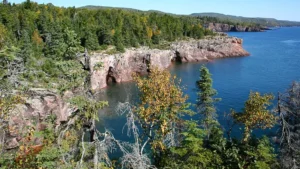
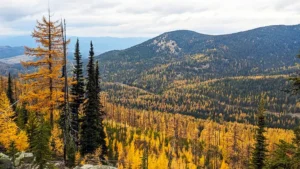
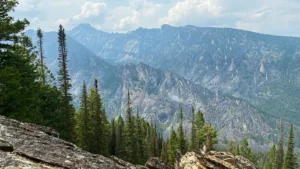

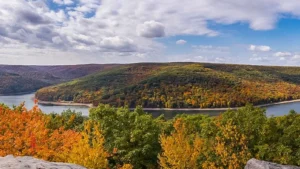

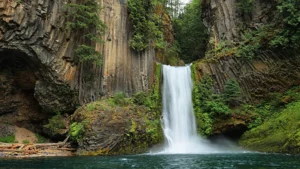
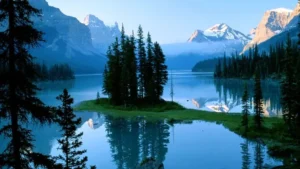
Leave your comment